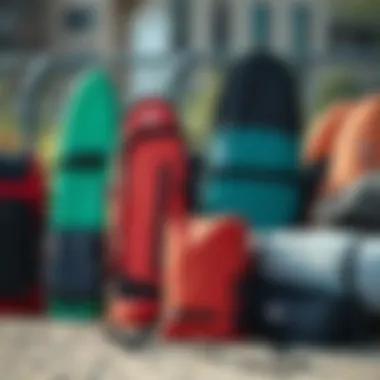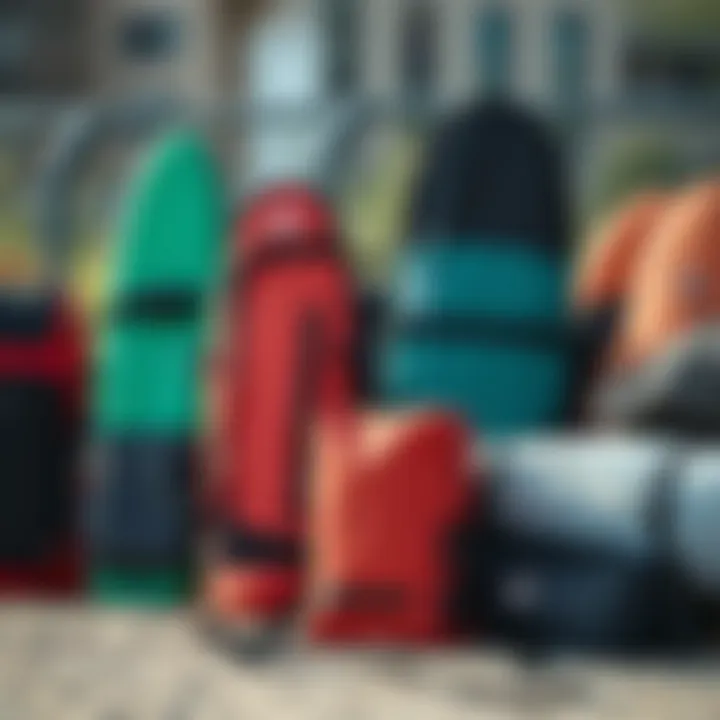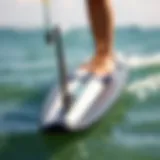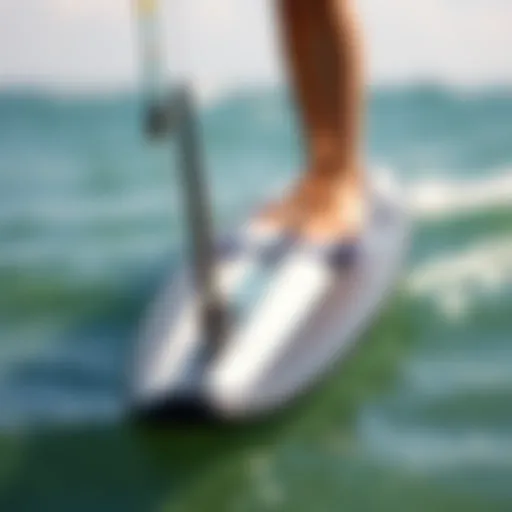Essential Insights on Wingfoil Board Bags for Enthusiasts


Intro
Wingfoiling, a sport that harmoniously blends the elements of kiteboarding and windsurfing, is rapidly gaining popularity among water sports enthusiasts. As with any thrilling outdoor activity, the importance of taking proper care of your equipment cannot be overstated. This is where wingfoil board bags come into play. These bags are not just an afterthought; they serve as a vital barrier against the whims of nature and the wear and tear of travel.
In this comprehensive guide, we will navigate the intricate landscape of wingfoil board bags. We will explore why these bags matter, how to choose the right one, and what features to consider to ensure your gear remains in top-notch condition. We'll also touch on various materials and designs, along with insights from seasoned kiteboarders who have put these bags through their paces.
Whether you're a novice wading into the waters of wingfoiling or an experienced rider looking to upgrade your gear, this guide promises to equip you with the knowledge you need to make informed choices. By the end, you'll be well-versed in how to optimize your wingfoil experience and ensure that your equipment gets the protection it rightly deserves.
Let’s dive in and unravel the essentials of these indispensable accessories that will safeguard your passion for kiteboarding.
Intro to Wingfoil Board Bags
When you step into the thrilling world of wingfoiling, your gear quickly becomes more than just equipment; it turns into a vital investment in your sport and lifestyle. That's where wingfoil board bags come into play. These bags are not merely accessories but essential tools that safeguard your cherished gear from wear and tear, environmental factors, and the rigors of transport. Choosing the right board bag involves several considerations, but understanding its importance is key for anyone passionate about wingfoiling.
One of the primary roles of a wingfoil board bag is to protect your equipment. A robust, well-padded bag can mean the difference between arriving at your destination with intact gear or facing costly damage. Think of it like this: you wouldn’t travel with a prized musical instrument without a proper case. Similarly, your wingfoil deserves the best possible protection against dings, scratches, and harsh conditions.
Moreover, convenience during transport cannot be overstated. Wingfoil board bags often come with features such as comfortable shoulder straps, extra storage pockets, and even wheels for easy maneuvering. These make hauling your equipment as effortless as possible, whether you are heading to the local beach or catching a flight to a distant surf spot.
It's also essential to recognize the role of wingfoil board bags in enhancing your experience on the water. A well-designed bag makes organizing your gear intuitive, ensuring that everything from the board to the foil and accessories fits snugly and securely. For novices, this attention to detail can alleviate some common stresses associated with getting set up on the water.
In essence, investing time into selecting the right wingfoil board bag isn’t just about convenience; it’s about understanding its value regarding protection and utility. In a sport where every moment counts, having gear that is easy to carry, well protected, and organized can drastically improve your time spent on the water.
“You put all that time and money into your gear, getting it scratched or damaged isn’t just frustrating—it can be a serious setback.”
As we delve deeper into this comprehensive guide, we’ll explore various facets of wingfoil board bags, from types and materials to features and care tips that set apart a good bag from a great one.
Importance of a Quality Board Bag
Investing in a high-quality board bag is crucial for any serious wingfool enthusiast. It's not just about having a case to toss your equipment in; rather, it's about safeguarding your investment and ensuring mobility. A good board bag does more than just protect the board; it provides peace of mind when traveling and handling your gear.
Protecting Your Investment
Wingfoils can be quite an investment, often costing hundreds or even thousands of dollars. The last thing you want is a chip or fracture ruining your day on the water. A durable board bag acts like a guardian angel. It protects against scratches, dings, and even major impacts that can occur during transport.
Consider a board bag with thick padding and rugged materials. For instance, bags lined with EVA foam give added protection against shocks. Think of it this way: you wouldn’t drive around with a fancy car without any insurance, would you?
Moreover, moisture can be a sneaky adversary. If you're traveling from a sunny beach to a damp mountain region, conditions can shift quickly. A bag that is resistant to water can keep mold and mildew at bay, preserving the integrity of your gear for years to come.
Convenience for Transport
Traveling with wingfoil gear can feel like a circus act if you don’t have the right bag. A quality board bag simplifies this process immensely. Not only should it be lightweight, but it should also come with handles and possibly even wheels for easy maneuverability. Having a bag that you can just throw over a shoulder or roll through an airport frees you up to manage other belongings.
Additionally, well-placed pockets and compartments provide easy access to smaller items like fins or harnesses. Imagine digging through a bottomless pit of a bag while juggling your routines at the airport. It's much easier to slide in your gear, close it up, and be on your way. When everything is organized, you’ll spend less time stressin' and more time riding the waves.
"A well-designed board bag is like a dependable companion on your journeys, keeping your gear safe and your mind at ease."
In essence, the importance of a quality board bag cannot be overstated. It's far more than an accessory; it's a necessity for anyone serious about their wingfoil experience. By choosing wisely, you're not just buying a product; you are making an investment in your passion.
Types of Wingfoil Board Bags
Understanding the various types of wingfoil board bags is crucial for choosing the right one that meets your needs. Each bag type brings its set of features, advantages, and target audiences. Depending on whether you're a seasoned kiteboarder or just starting, knowing the differences helps you make a wise investment.
Soft vs. Hard Cases
When it comes to selecting a board bag, you'll typically face the choice between soft and hard cases. Each has its merits and drawbacks, depending on factors such as how often you travel, the level of protection you require, and your budget.
Soft Cases are often lighter and easier to carry, which is a big plus for those who travel frequently. They're typically made from durable nylon or polyester and often come with some padding. The flexibility of a soft case makes it easier to fit into various spaces. However, this flexibility may come at the cost of protection; they may not fully shield your gear from heavy impacts.
"Choosing between soft and hard cases is like picking between a cozy blanket and a solid shield. Both keep you warm, but one offers comfort while the other offers armor."
Hard Cases, conversely, provide exceptional protection. Constructed from rigid materials, they can withstand tough conditions, making them perfect for long-distance travel. The downside? They can be cumbersome and heavy, not ideal for a quick trip to the beach. The extra weight and bulk generally demand more storage space, so it’s essential to weigh this against your travel style.
In summary:
- Soft Cases: Lightweight, flexible, adequate for local use but less protective.
- Hard Cases: Superior protection for extensive travels, heavier and bulkier.
Single vs. Double Board Bags


When narrowing down your options, the choice between single and double board bags can significantly affect how you transport your gear.
Single Board Bags are designed to hold one board along with some extra accessories. This is usually sufficient for those who have only one favorite board or are just starting out. One motorcycle might be enough, but if you’ve got a few tricks up your sleeve or prefer riding different boards for varying conditions, then you’re looking at a Double Board Bag. These bags can fit two boards, providing a practical solution for those who prefer versatility. You can pack your surfboard and foil board together, ensuring you’re ready for whatever the day sends your way.
However, double bags can sometimes become cumbersome, particularly if you tend to travel solo. The added weight might require a bit more muscle on your part, but the convenience of having two boards at your disposal often outweighs this.
To sum it up:
- Single Board Bags: Best for individual board owners, lighter and more compact.
- Double Board Bags: Ideal for those who like multiple setups, though at the cost of higher weight and bulk.
Choosing the right type of wingfoil board bag not only enhances your travel experience but also ensures you’re covered on all fronts. Being aware of your preferences and needs can guide you in making a wise choice.
Key Features to Consider
When it comes to wingfoil board bags, not all are created equal. Various features can make or break your experience on the water, and understanding these factors is vital for any wingfoiling enthusiast. This section dives deep into crucial aspects like size and compatibility, padding and protection, and storage compartments. Knowing these elements will ensure that the investment you make in a board bag serves your needs well, safeguarding your gear without unnecessary hassle.
Size and Compatibility
Choosing the right size for your wingfoil board bag can feel like navigating a maze, given all the options out there. A misstep here could lead to disastrous results, such as a bag that's too tight, causing wear or damage over time. The primary element to focus on is ensuring that the bag you select complements your specific board dimensions.
For example, a 8 foot board will definitely require a bag sized appropriately to not only accommodate the board’s length but also allow for some extra room to ease packing and unpacking.
- Considerations include:
- Board dimensions: Always measure your board from nose to tail and width.
- Foil attachment: When your board is rigged with a foil, the bag needs to offer enough room to prevent pressure points.
- Compatibility with accessories: Some boards come with added gear that can increase their size. Ensure the bag has sufficient dimensions to cater to all elements without cramming everything in.
Padding and Protection
The level of padding in your board bag is akin to choosing the right insurance policy — it essentially determines how safe your gear will be during transport. Without adequate padding, even the most durable boards can suffer from dings and scratches over time.
Key points to think about include:
- Thickness of padding: A bag with at least 5mm of padding is recommended for those who intend to travel frequently.
- Material of padding: Look for bags with high-density foam or gel-padding as these materials offer robust protection without adding excessive bulk.
- Reinforced areas: Certain bags feature reinforced ends or sides that guard against impacts when carried or loaded onto vehicles.
Storage Compartments
When hitting the road or heading to the beach, having well-designed storage compartments is a game-changer. The right storage can keep your gear organized, preventing that banging around of your equipment that can lead to unexpected disasters.
Opt for board bags with:
- Separate storage pockets: For carrying accessories such as fins, leashes, and straps, dedicated pockets prevent them from getting tangled with the main board.
- External compartments: Perfect for dry bags or personal items, these compartments allow you to access essentials without digging into the entire bag.
- Straps or loops: Look for bags that come with additional loops or straps to secure items on the outside, ideal for stowing away extra gear while traveling.
When considering these features, keep the ideal balance of your preferences and the practical needs that arise while wingfoiling. Investing in a board bag that ticks all the boxes ensures a smoother, more enjoyable wingfoiling experience.
Materials Used in Construction
When choosing a wingfoil board bag, the materials used in its construction can heavily influence the durability and overall functionality of the bag. The right materials can mean the difference between a bag that protects your valuable gear and one that falls apart after a few trips.
Nylon vs. Polyester
Both nylon and polyester rank among the top contenders in the realm of materials for board bags, each with distinct advantages. Nylon is known for its superior strength-to-weight ratio, making it an ideal choice for those who prioritize lightweight options without sacrificing durability. It often withstands abrasions better, which is essential when boards are frequently loaded and unloaded.
Polyester, on the other hand, is generally more affordable and provides excellent UV resistance, which can be crucial during long days spent under the sun. It tends to be less susceptible to fading over time. While both materials have their merit, your selection should depend on your specific needs. A nylon bag may serve you well if you expect to do quite a bit of traveling; whereas for those content with local outings, the polyester option could be both practical and budget-friendly.
Waterproofing Characteristics
The importance of waterproofing in a board bag cannot be overstated—especially for wingfoil enthusiasts who often find themselves at the mercy of unpredictable weather. A waterproof bag can prevent moisture damage to both the gear inside and the bag itself. When looking at waterproofing, consider the following:
- Fabric Treatment: Many bags undergo treatments that enhance their resistance to water penetration. Look for options described as having a PU (polyurethane) coating, which can add a crucial layer of defense against the elements.
- Zipper Sealing: Water-resistant zippers are vital. A bag might boast the most impressive waterproof fabric, but if the zipper is prone to leaking, it undermines the entire point of having a waterproof bag. Sealed or covered zippers can mitigate this issue.
"A well-constructed board bag not only shields your gear but also serves as a sturdy companion during your travels."
In summary, understanding the materials underpinning your wingfoil board bag can greatly improve your choice. Whether it's opting for nylon versus polyester or weighing the waterproofing techniques in place, taking the time to consider these aspects can save you significant trouble in the long run. From rainy commutes to sun-soaked adventures, a bag built from the right materials will stand the test of time.
Top Wingfoil Board Bags on the Market
When it comes to transporting your wingfoil gear, choosing the right board bag is paramount. The market is teeming with options that range widely in quality, design, and features. A good board bag doesn’t just hold your gear; it protects your investments while making your trips smoother. As any kiteboarder knows, the last thing you want is to arrive at your destination to find your board’s surface marred or damaged. This is where quality bags truly shine. They are your first line of defense against the rigors of travel, whether you’re heading down to the beach or flying across the globe.


Brand Comparisons and Reviews
Within the realm of wingfoil board bags, several brands stand out for their innovation and quality. Here are a few notable ones:
- ProLimit: Known for their high-quality materials and user-centric designs, ProLimit bags often come with ample padding and excellent waterproof features.
- Naish: Naish board bags are celebrated for their durability and style. Their double board bags are especially popular among avid kiteboarders, thanks to their spaciousness and sturdy construction.
- Dakine: Dakine offers a variety of options across different price ranges. Their bags frequently have compartments for fins and other accessories, which many users find extremely beneficial.
To assess these brands, it’s important to examine real user reviews. Many kiteboarders often share their experiences in forums or on social media platforms like Reddit, providing invaluable insights into how these bags perform in real-life situations. Not only do you get a sense of their durability, but you can also gauge how user-friendly they are during travel.
Price Range and Value Assessment
The price of wingfoil board bags can vary significantly, ranging from $50 for basic models to over $300 for high-end options. Choosing the right price point involves balancing your budget with the level of protection and features you desire.
- Budget Bags ($50 - $100): These tend to offer minimal protection. They may lack the padding that pricier models have, but they’re great for casual users who don’t travel far.
- Mid-Range Bags ($100 - $200): In this bracket, you'll find options that generally strike the best balance between quality and cost. Brands like Dakine and ProLimit often feature here, providing decent materials and thoughtful design.
- Premium Bags ($200 - $300+): High-end bags often come with almost every bell and whistle you can think of, including advanced waterproofing and thermal insulation. These are suited for those who travel frequently or have high-quality gear they want to keep in pristine condition.
"Investing in a quality board bag not only prolongs the life of your gear but can save you money in the long run by avoiding costly repairs or replacements."
Deciding on how much to spend on a board bag can be a bit like picking a favorite kiteboard; it's a personal decision that should reflect your usage, travel frequency, and how much protection your gear requires. Keep your eyes peeled for seasonal sales, especially during the off-peak months, to score better deals. Paying attention to customer feedback and product specifications helps in making an informed choice, ultimately enhancing your wingfoil experience.
Care and Maintenance Tips
Taking a little time to care for your wingfoil board bag not only prolongs its life but also ensures it serves its purpose effectively. Just like any piece of gear, a board bag undergoes the wear and tear of travels and adventures. It’s muddy, sandy, and sometimes even soaked in sea water. Therefore, knowing how to keep it in top shape is crucial for everyone who takes to the water.
Cleaning Your Board Bag
Cleaning your board bag should be a regular part of maintenance. Failure to do so might lead to unwanted odors or even mold growth. To start, always consult the manufacturer's instructions, if available. Typically, though, you can perform a good clean by following these steps:
- Remove All Contents: Take out any inner pockets or compartments. Check for loose items and pockets that may have gathered sand.
- Rinse Off Debris: Use a gentle stream from a hose or bucket to remove sand and dirt. Avoid high-pressure water as it might damage the seams or fabric.
- Use Mild Soap: Mix a small amount of mild soap with warm water. Any household dish soap usually works well. Dip a soft brush or cloth into this soapy water and scrub the bag gently. Pay more attention to areas with stains or heavy soiling.
- Rinse Thoroughly: After scrubbing, ensure you rinse off all soap and debris. Leftover soap can attract dirt and cause more buildup in the future.
- Air Dry Completely: Lay the bag out flat in a shaded area to dry. Avoid direct sunlight as it can deteriorate the materials over time.
Keeping your board bag clean doesn’t just enhance its look but significantly contributes to its longevity. A clean bag reflects care, both for your gear and for your riding experience.
Storage Practices
Storing your wingfoil board bag the right way can save you from future hassle. If you just toss it into the corner of the garage, you're asking for trouble. Here are some tips to consider for optimal storage:
- Avoid Extreme Temperatures: Don’t let your bag bake in the sun in a hot car or freeze in a cold garage. Climate extremes can warp or damage the materials. Keeping it at room temperature is ideal.
- Empty It: Always remove all contents before storing. Items can cause indentations or even mold growth if left inside.
- Seal It Up: If your bag comes with a storage pouch or has a way to wrap up tightly, use it. This protects the bag from dust and elements.
- Hanging or Laying Flat: If space allows, hang the bag in a closet using a hook. If hanging isn’t an option, store it lying flat, not crumpled, to preserve its shape.
- Regular Checks: During the off-seasons, check the bag occasionally for any signs of wear or damage. Early detection can help avert bigger problems down the line.
Adopting these simple cleaning and storage practices ensures your wingfoil board bag stays ready for action whenever you are. Remember, a little time spent maintaining your equipment saves you from larger headaches later on.
Traveling with Wingfoil Gear
When preparing to hit the waves, traveling with your wingfoil gear takes on a special significance. The thrill of adventure goes hand in hand with the proper logistics of transport, whether it’s making your way to a remote beach or a local lake. The right approach not only preserves your equipment but also enhances the overall experience—from check-in at the airport to setting up your rig on the shore. Having an understanding of travel requirements can reduce the stress as you set off for your destination, allowing you to focus on what really matters: the ride.
Airline Regulations and Fares
Airlines can be a tricky maze when it comes to traveling with large items like wingfoil gear. Each airline has its own set of rules regarding sports equipment, and knowing these can save you time and money. Here are some key points to consider:
- Check the weight limits: Before anything, ensure you know how much your gear weighs and what each airline allows. Many airlines charge hefty fees for overweight luggage.
- Dimensions matter: Most airlines specify maximum dimensions for checked items. Measure your board bag carefully. A bag that's just a few centimeters over the limit might increase costs or cause baggage rejection.
- Special handling: Some airlines require you to declare sports equipment at the time of check-in, which may come with a different fee. It’s often beneficial to check in online beforehand to avoid surprises at the airport.
- Provide cushioning: Airlines may not take extra care to protect your gear. Using bubble wrap or foam padding can be a lifesaver, ensuring your equipment stays intact.
Ultimately, knowledge of the policies can make for a smoother experience—not just at the airport but also in terms of anxiety over potential damages.
Tips for Efficient Packing
Packing your gear can feel like trying to fit a square peg into a round hole, but with the right planning, it can be manageable:
- Use a quality board bag: This step cannot be overlooked. A well-padded bag will shield your board and accessories from shocks and dings.
- Optimize your space: Roll your wetsuit and clothing to save space; this method allows you to fit more into the bag while also keeping it wrinkle-free.
- Protect the fragile pieces: Store fins and wing handles in separate compartments or wrap them in clothes to avoid unwanted jostling. A little foresight here goes a long way.
- Bring only essentials: Avoid overpacking. A few days on the beach usually calls for a couple of board shorts, a hat, and flip-flops. Less is more when it comes to luggage.
- Keep important items readily accessible: Don’t put your passport, tickets, or any necessary documentation deep in your bag. Use an external pocket if your board bag has one.
By sticking to these tips, you can minimize the hassle of packing and ensure your wingfoil gear is ready for action when you hit the beach.
"The journey of a thousand miles begins with a single step, or in our case, a well-packed travel bag."
Traveling with wingfoil gear doesn’t have to be a daunting task if you approach it with knowledge and strategy. The tips provided can transform the way you embark on your next adventure, paving the way for unforgettable moments on the water.
Innovations in Wingfoil Board Bags
The world of wingfoiling is constantly evolving, with new technologies and materials making their way into every facet of the sport. This evolution extends notably to wingfoil board bags, which have transformed from simple protective covers to advanced solutions tailored specifically for the modern wingfoiler. The importance of these innovations can't be overstated; they reflect not only a response to the changing needs of riders but also an exciting enhancement of the overall experience on the water.
Tech-Integrated Bags


As technology becomes ubiquitous in our lives, it's no surprise to see it extend into the realm of wingfoil board bags. Many leading brands now offer tech-integrated bags that facilitate smarter transportation of gear. A prime example lies in bags equipped with GPS tracking, allowing adventurous kiteboarders to keep tabs on their equipment. This feature is particularly beneficial in busy areas where gear can be easily misplaced.
Some bags come with built-in solar panels to charge your electronics while you're out enjoying the sun. Thus, your smartphone or GPS device can remain powered, making it easier to navigate back to shore if you drift off course.
"A tech-integrated wingfoil bag not only protects your gear but also enhances your overall riding experience."
*
It's also worth mentioning the rise of smart fabrics that respond to weather conditions. For instance, some materials can become more rigid in colder temperatures, providing enhanced protection, while remaining light and flexible when the heat is on. This balance between functionality and form becomes a focal point for the innovative wingfoil bags.
Sustainable Materials
In an era where environmental awareness is crucial, the push toward sustainability has reached the world of wingfoil board bags. The growing concern over plastic waste and the demand for eco-friendly options have prompted manufacturers to seek alternatives. Sustainable materials have started entering the production line, such as recycled plastics and organic cotton. These materials not only reduce the environmental footprint but often deliver equal or even superior performance compared to traditional materials.
Moreover, companies are adopting practices that prioritize sustainability. This includes decreased reliance on harmful chemicals during production and using energy-efficient methods in manufacturing processes.
One interesting element is the use of natural fibers, such as hemp or flax, which have gained traction for their biodegradability and durability. As kiteboarders become increasingly conscious about their ecological impact, bags constructed from these sustainable sources are likely to become more popular.
In summary, the innovations surrounding wingfoil board bags illustrate how the industry adapts to rider needs, merges technology with practicality, and embraces a more eco-friendly approach. For kiteboarders, this means not only enhanced protection for their beloved gear but also a step towards reducing their overall environmental footprint.
User Experiences and Testimonials
The world of wingfoiling is as diverse as the individuals who participate in it. When diving into User Experiences and Testimonials, it’s clear this provides invaluable insights that help both new and seasoned riders alike make informed decisions. Testimonials from fellow enthusiasts reflect real-world use, offering a peek into the practical aspects of various wingfoil board bags. The accumulated wisdom from the community helps underline several important points about choosing the right gear.
Insights from the Community
Many riders stress the importance of sharing their experiences. From the guy who dropped a hefty sum on a bag that turned out to be more fluff than substance to the woman whose budget-friendly bag stood the test of time, these stories can be quite illuminating. Here are some core themes that often surface in discussions:
- Real Use Cases: Feedback about how well a bag held up in different conditions—whether it was a rocky beach or the hold of an airline—can’t be underestimated. For example, community members on Reddit discuss their heart-stopping moments when sharp-edged equipment rubbed against their board bags during a turbulent flight. Posts like these capture not just the technicalities but also emotional narratives.
- Durability Tests: Riders often mention scenarios that help gauge the resilience of board bags. Someone might recount a week-long trip where their bag faced wet and salty conditions. Did the bag lose form or provide ample protection? The answers can influence future purchases.
- Comparative Insights: When enthusiasts compare features across various brands, it illuminates often-overlooked aspects, like layout and design of extra compartments. Who hasn’t cursed when their gear gets tangled? Conversations about bags with intuitive pocket placements can lead to valuable insights.
Common Issues and Solutions
Even the best board bags aren’t without their flaws. It’s not uncommon for users to voice concerns after buying a new bag. Here are some common issues as reported within the community, along with practical solutions:
- Zipper Failure: One of the most frequent complaints includes malfunctioning zippers. Several members have found that replacing stock zippers with sturdier YKK variants can significantly extend the longevity of their bags.
- Weight Factor: A frequent issue for travelers relates to excessive weight. People often find themselves hovering over the weight limit at airports, sighing deeply at those unforgiving baggage fees. As a tip, look for bags that offer a lightweight option without sacrificing protection. A number of community recommendations lead to bags with an optimized design that cleverly cut down weight while keeping the essential padding intact.
- Padding Concerns: Some users report that certain bags don’t provide adequate cushioning for their boards, leading to damage during transport. The straightforward advice shared in forums is to prioritize well-padded bags, perhaps favoring those with at least 8 mm of cushioning—especially if you plan to frequently haul your gear long distances.
Ultimately, input from the community reveals how gear performs under pressure. By weaving together shared experiences, kiteboarders can arm themselves with better knowledge, leading to more satisfying choices in wingfoil board bags. The support system built through shared stories often creates not just informed buyers, but also a sense of camaraderie among riders.
Finale
In closing, understanding the critical aspects of wingfoil board bags is paramount for anyone who relishes the thrill of the sport. As kiteboarders, we often invest significant time and money into our gear. Not only does a solid board bag protect that investment, it also contributes to ease of travel and enhanced overall experiences on the water.
One of the most salient points discussed throughout this guide is the importance of quality construction. A well-made board bag not only shields against physical damage but also helps maintain the integrity of the gear against weather-related wear, which can easily sneak up on a careless traveler. Different materials, such as nylon and polyester, present their strengths and weaknesses, and knowing these can save you from a trip-ending mishap.
When considering features like storage compartments, padding, and size compatibility, it’s critical to align your selection with your specific needs. If you’re a frequent traveler, the right bag might mean the difference between a hassle-free check-in and a frustrating airport experience.
All in all, whether you’re just dipping your toes into the world of wingfoil or you’re a seasoned veteran, investing time to understand board bags will yield dividends in protecting your gear and enhancing your sporting adventures. The right bag fits like a glove and takes your experience from good to great. Taking the knowledge acquired here and applying it during your purchasing process will elevate your time in the water.
It’s better to invest in a quality board bag today than to face the agony of a damaged board tomorrow.
For further exploration into wingfoil gear and maintenance tips, resources like Wikipedia and Reddit offer community insights and product reviews.
In the end, being informed is the first step towards making smarter choices that align with your passion and commitment to the sport.
Appendix
The appendix plays a crucial role in adding depth to any comprehensive article, particularly this guide on wingfoil board bags. While the main content addresses essential aspects like protection, types, and features of board bags, the appendix serves as a valuable support framework. It provides readers with additional resources, ensuring they have access to the best information available regarding their wingfoil gear. This is particularly helpful for both seasoned kiteboarders and newcomers, offering clarity and a broader perspective on the subject.
Resources for Further Reading
Diving deeper into the world of wingfoiling requires an up-to-date understanding of both gear and techniques. Below are exemplary resources designed to expand your knowledge:
- Wikipedia: An extensive overview of wingfoiling can be found on Wikipedia.
- Britannica: For historical context and development, Encyclopedia Britannica offers solid articles on the evolution of board sports. Visit Britannica.
- Reddit Communities: Engaging with fellow enthusiasts on platforms like Reddit provides real-time advice and experiences. Check out subreddits such as r/wingfoiling for direct input from seasoned riders.
- Facebook Groups: Joining Facebook communities can be beneficial. Many groups focus specifically on gear reviews and tips. Try searching for wingfoiling groups—many are very active and helpful.
Links to Products Reviewed
The practical side of choosing the right wingfoil board bag involves examining actual products. Here are links to some respected reviews across the internet:
- **E-commerce Sites:
Amazon: Check for user reviews and ratings here Amazon. - Gear Review Sites: Specialized sites like The-House provide deep dives into product quality and features, making them excellent resources. Visit The-House.
- Forums and Blogs: Many kiteboarding blogs discuss gear extensively. A good example is KiteForum, where enthusiasts share personal experiences and recommendations. Access it at KiteForum.
“The right equipment can turn your worst day on the water into an exhilarating adventure. Don't overlook the importance of quality gear.”
In summation, the appendix not only supplements the guide but also acts as a stepping stone for a richer understanding of wingfoiling. With these additional resources and product links, readers can further explore the intricacies of selecting the best board bag that suits their unique needs.















